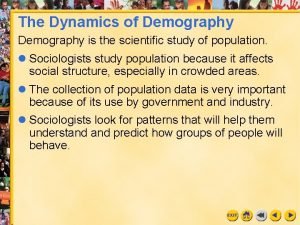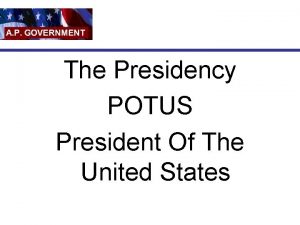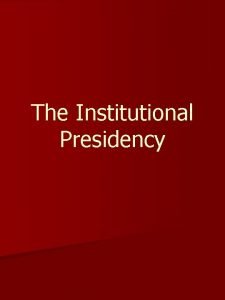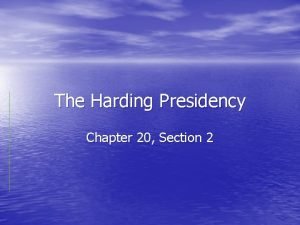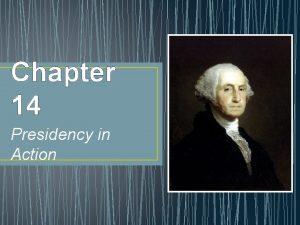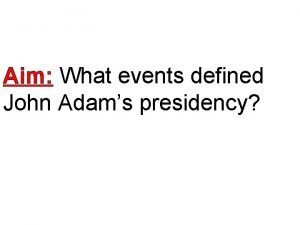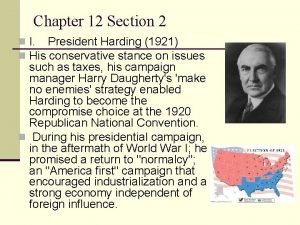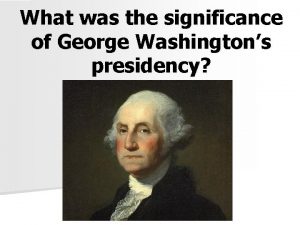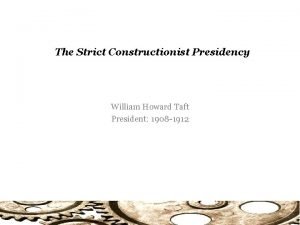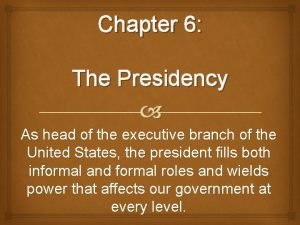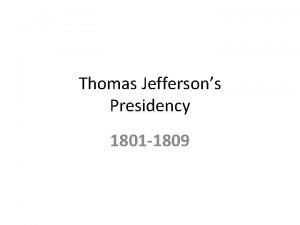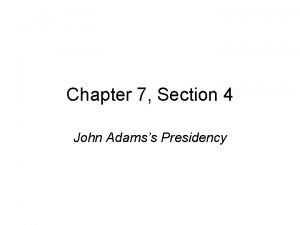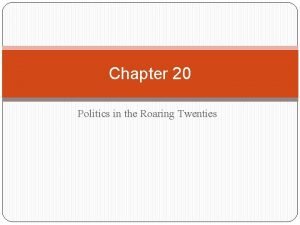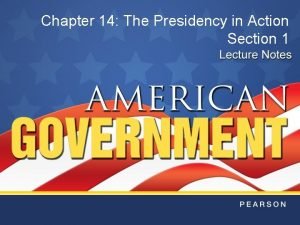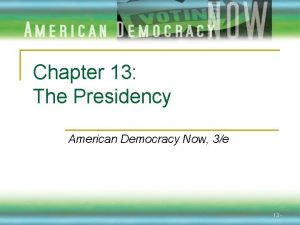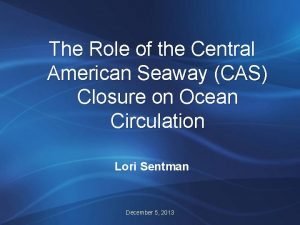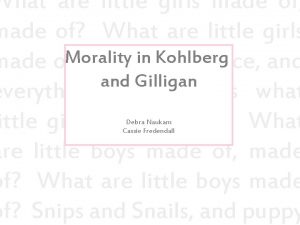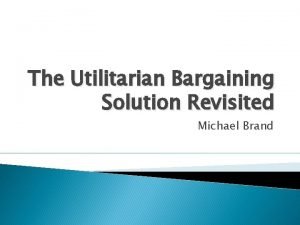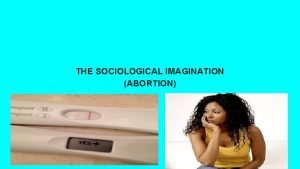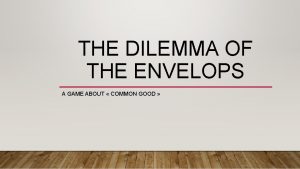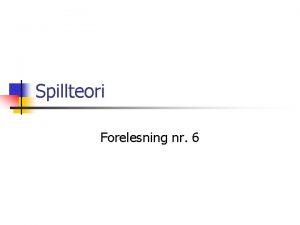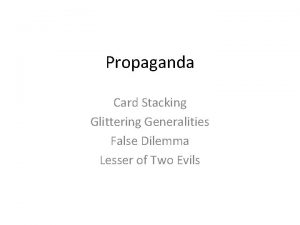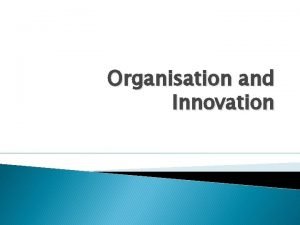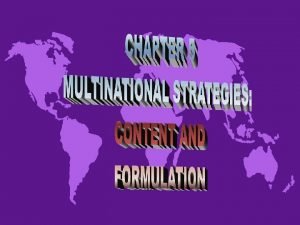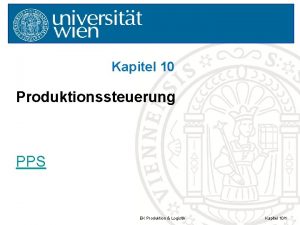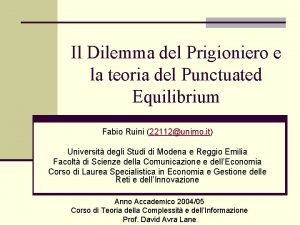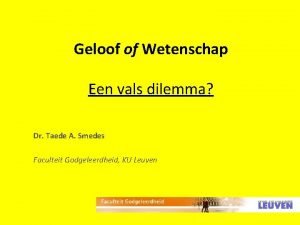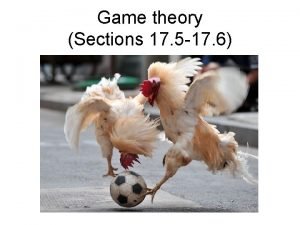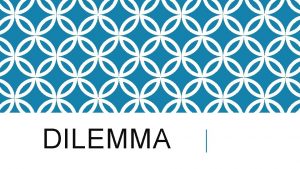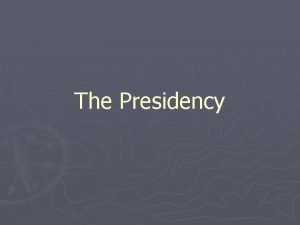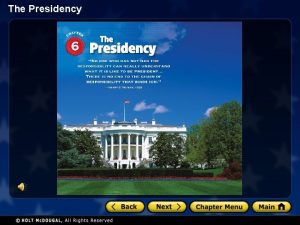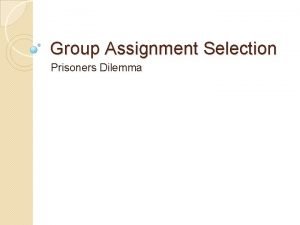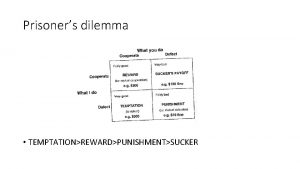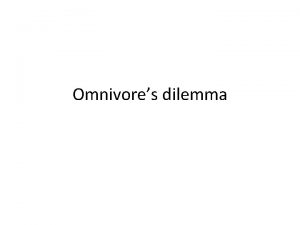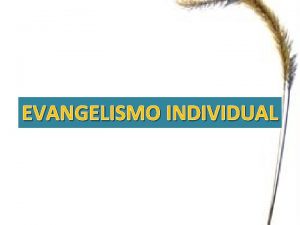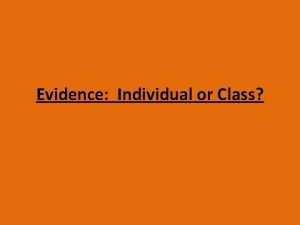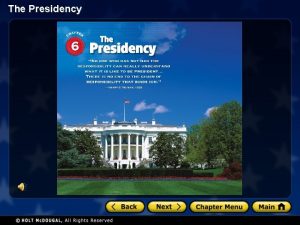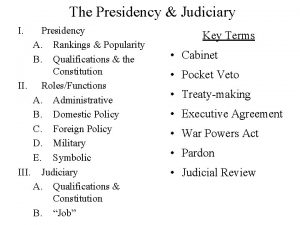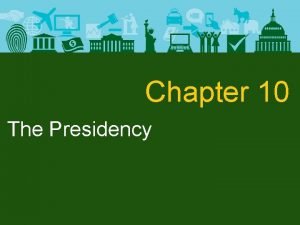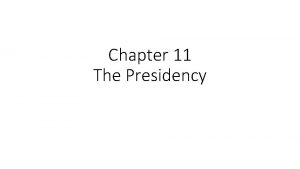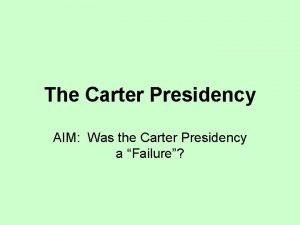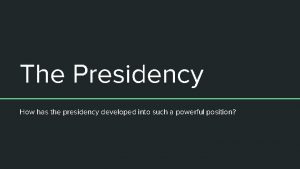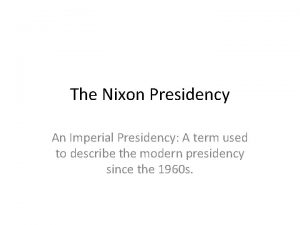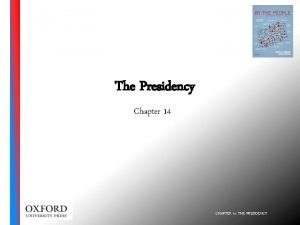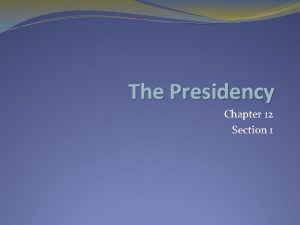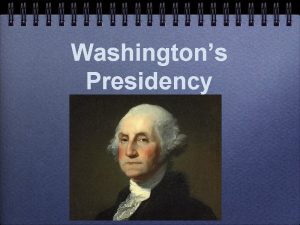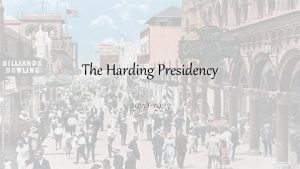The American Presidency The Central Dilemma The individual

































- Slides: 33

The American Presidency


The Central Dilemma • The individual (his personality, skills, etc. ) versus history (environment, nature of times) • Do great presidents make history or does history make them? • Would a president other than Lyndon Johnson have passed the civil rights legislation of the 1960 s? • Would a president other than FDR have gotten us through the Great Depression and WWII? • Would a president other than Reagan have dealt as effectively with the Soviets?

Historical Powers of the Presidency: 1. The Traditional President (late 1700 s-early 1930 s): presidents did little during this period, and Congress was generally dominant [exceptions? ] 2. The Modern President (early 1930 s-mid-1970 s): a powerful activist presidency prompted by the Great Depression and WWII, Congress become less dominant. 3. The Postmodern President: a weakened presidency whose powers have been sapped by relative economic decline and the growth of interdependence. The world has now “closed in on” the American presidency. The main result of this is that in this new era a president must “go international’ in order to get much of anything done.

Art. II Constitutional Qualifications of POTUS: (a) (b) (c) (d) (e) 35 or older natural born 14 years of residency term limits (22 amendment-2 terms) disability of president - 25 th amendment. A new non-elected VP needs approval from both houses. (g) popularly elected – but indirect election through Electoral College. Many world leaders not elected but selected by someone. i. e. , PM’s are chosen by the majority party.

TERM & SUCCESSION: • 2 Term precedent – from who to who? • 22 nd Amendment – 1951 – how long can POTUS actually serve? • Should this amendment be repealed? • Reasons for succession: • Death, resignation, impeachment AND conviction, temporary or permanent disability • Order of succession: • Determined by Congress – POTUS Succession Act • VP, Speaker, Pres. Pro Tempore, Sec. of State …. other cabinet members in order of

SALARY & BENEFITS: • $400, 000 Salary • (VP= $230, 700 & 10 K expense account) • $50, 000 Expense Account +… • Benefits: • • • Housing Transportation Health Care Secret Service for Life Pensions Movie Theatre

ELECTION • ELECTORAL COLLEGE • POTUS & VP are only 2 offices in this country elected by the electoral college method • Malapportionment • CA has approx. 1 electoral vote for every 500, 000 voters; AK has 3 electoral votes for every 245, 578 people.

Electoral College • 4 times winner of popular vote has NOT won the POTUS election • • 1824 1876 1888 2000 – – Jackson lost to John Q. Adams Tilden lost to Hayes Cleveland lost to Benjamin Harrison Gore lost to George W. Bush (43) • Election date is always the Tuesday after the first Monday in November. • Inauguration is always Jan. 20 (per the 20 th Amendment) • Oath of office is administered by the Chief Justice of the Supreme Court

LEADERSHIP ATTRIBUTES OF POTUS: • Ability to: • • • manage a crisis demonstrate leadership appoint quality officials & judges set & clarify the national agenda achieve success in the foreign policy arena Democracy Equality

POTUS vs. Prime Minister • How is a POTUS different from a Prime Minister? • • POTUS has term limit PM has no divided gov’t PM is longtime party leader Party discipline is better in a parliamentary system

Art. II: Powers & Duties of the President CHIEF EXECTIVE head of Executive Branch CIA, FBI, NSA, US Attorneys, etc…. POTUS must enforce the Laws!! COMMANDER IN CHIEF head of ALL armed forces

Constitutional Powersb Art. II: Powers & Duties of the President POWER TO SIGN OR VETO laws passed by Congress **2/3 in both houses to override a veto** GRANTS REPRIEVES & PARDONS Reprieves = delay of punishment Pardon = forgiveness

Art. II: Powers & Duties of the President MAKE TREATIES with other countries -must be approved by 2/3 of Senate -can also make Executive Agreements -what’s the difference? MAKE APPOINTMENTS to cabinet, Supreme Ct. , ambassadors, etc. - Must be approved by Senate (a new POTUS makes approx. 3, 000 appointments) Duty to report to Congress & the people on THE STATE OF THE UNION

POWERS OF THE PRESIDENT Appointments: • To federal offices (bureaucracy) • Federal/SCOTUS judicial positions • Cabinet • Divided Government poses problems in appointment – why? • Harder to get Senate approval • Ideological conflicts • Offices may go unfilled

POWERS OF THE PRESIDENT Power of Appointment: • So… how do appointments get confirmed? • go to public for support • build coalitions in Congress • make deals and compromise • diversify in his choices • do more background screening • Recess appointments: Making appointments while the Senate is out of session. (No Senate confirmation)

Presidential Power • • Presidential power is “the power to persuade” A president’s power is related to the perception of three audiences: 1. Washington D. C. Insiders (Senate, House of Representatives, Supreme Court) 2. The party activists and officeholders outside Washington, IG’s 3. The mass public at large 4. A fourth audience today?

ROLES OF POTUS: • Chief of State • Chief Executive • Chief Administrator • Chief Diplomat • Commander in Chief • Chief Legislator • Chief of Party • Chief Citizen

Commander in Chief “War-making” Power of POTUS can commit troops in 1 of 3 ways: • Declaration of war by Congress (only 5 times in history) • National Emergency (natural disasters) • If use of force is in national interest War Powers Act of 1973 • POTUS must advise Congress of troop deployment within 48 hours – keep Congress advised • Commitment of troops ends after 60 days UNLESS approved by Congress

War Powers…. War Powers Act has not yet been resolved by SCOTUS • All POTUS have deemed War Powers Act unconstitutional &, in many cases, ignored it POTUS who have flaunted war powers? Reagan – Grenada Bush, Sr. – Kuwait/Desert Storm Clinton – Haiti /Bosnia George W. – Iraq Obama – Osama Bin Laden (2011), Libya (2011), ISIS, Drone Strikes? ?

POTUS as Chief Executive (Administrative Powers) Two resources for controlling the bureaucracy? • Appointment of top level administrators • Recommending budgets to Congress The Cabinet • 15 cabinet positions (Homeland Security is newest) White House Staff • Chief of Staff; Deputy Chiefs; Senior Advisors; Counsel

THE EXECUTIVE DEPARTMENTS “EXECUTE ALL LAWS” EOP (Executive Office of the President) • Created by FDR – 1939, to support administration • Chief of Staff – POTUS top aide, manages EOP • National Security Council, OMB, Council of Economic Advisors, Office of National Drug Control, Office of First Lady, Trade Representative…. • Directly advise POTUS on a daily basis • None elected – over 600 – most NOT subject to Senate confirmation.

Chief Legislator (Legislative Powers) • State of Union address to Congress & the people. Set national agenda. • Power to veto Only 4% of all vetoed bills overridden Line-item veto – Governors-YES, POTUS-NO POTUS ability to veto certain parts of a bill, without vetoing the entire bill.

EXECUTIVE ORDERS:

Chief Legislator ORDINANCE POWER • EXECUTIVE ORDERS – POTUS writes the law! • Source: Constitution: implied; to further acts of Congress • Can be overturned by Congress – don’t fund it or pass conflicting law OR by SCOTUS – held unconstitutional • Can also be overturned by future POTUS

Chief Legislator Execuative Orders

Chief Diplomat – Treaties & Executive Agreements • POTUS have exclusive power to grant diplomatic recognition to a nation (Palestine) • POTUS have exclusive power to negotiate treaties (Senate approves) • In addition to treaty-making power, POTUS also have power to negotiate executive agreements with heads of foreign governments • What’s the difference? • NO SENATE RATIFICATION IS REQUIRED in this! • Note: Treaties are binding on future POTUS, but executive agreements are not. • Most routine; non-controversial - food deliveries, customs • BUT, can implement important & controversial policies • NAFTA (Clinton), TPP, UN Paris Climate Agreements (Obama)

Relationship with the Media Press Sec’y Robert Gibbs • MUST have a good one! • Press Secretary (part of White House staff) deals with the press corps • POTUS gets much access to television spots • POTUS gets weekly radio address to discuss whatever he wants • POTUS have tried to control & spin the media since Watergate • Which POTUS had best relationship?

Public Approval • Polls used extensively • Average rating of outgoing Ps is 50% or less • During national emergencies, approval usually increases • Techniques that work: • FDR & Fireside Chats • Clinton & Town Hall Meetings • Factors affecting opinion of POTUS: • • • Pre & post election swings Ability to handle a foreign crisis CONDITION OF THE ECONOMY Leadership during a domestic crisis Ability to get programs through Congress

APPROVAL RATINGS:

IMPEACHMENT: • The President, Vice President & other public officials may be impeached & tried for treason, bribery & other high crimes & misdemeanors. • House of Reps impeaches (indicts) by a majority vote • Senate holds trial (jury) • Acquits or convicts (requires 2/3 vote) • What happens if convicted? • Only 2 POTUS have ever been impeached!


The Clinton Vote: • Clinton was impeached on two counts, grand jury perjury (228– 206) and obstruction of justice (221– 212), with the votes split along party lines. • Senate Republicans couldn’t get the two-thirds majority for conviction. • On Feb. 12, 1999, the Senate acquitted President Clinton on both counts. • The perjury charge failed by a vote of 55– 45, with 10 Republicans voting against impeachment along with all 45 Democrats. • The obstruction of justice vote was 50– 50, with 5 Republicans breaking ranks to vote against impeachment.
 Central city dilemma
Central city dilemma Presidential line of succession
Presidential line of succession Institutional presidency definition
Institutional presidency definition Chapter 20 section 2 the harding presidency
Chapter 20 section 2 the harding presidency Chapter 14 the presidency in action answer key
Chapter 14 the presidency in action answer key Summary of alien and sedition acts
Summary of alien and sedition acts George washingtons presidency
George washingtons presidency Chapter 6 the presidency
Chapter 6 the presidency Ch 12 section 2 the harding presidency
Ch 12 section 2 the harding presidency Washingtons cabinet
Washingtons cabinet Constructionist presidency
Constructionist presidency Which trend characterized thomas jefferson's presidency?
Which trend characterized thomas jefferson's presidency? Unwritten qualifications for president
Unwritten qualifications for president What were president jeffersons economic policies
What were president jeffersons economic policies Section 4 the presidency of john adams
Section 4 the presidency of john adams Chapter 20 section 2 the harding presidency
Chapter 20 section 2 the harding presidency Chapter 14 section 1 the growth of presidential power
Chapter 14 section 1 the growth of presidential power Chapter 13 the presidency
Chapter 13 the presidency Central american seaway
Central american seaway Kohlberg morality test
Kohlberg morality test Vangin dilemma
Vangin dilemma Stag hunt vs prisoner's dilemma
Stag hunt vs prisoner's dilemma Sociological imagination abortion
Sociological imagination abortion Outcome of prisoner's dilemma
Outcome of prisoner's dilemma Fangens dilemma
Fangens dilemma Lesser of two evils propaganda examples
Lesser of two evils propaganda examples Prisoners dilemma
Prisoners dilemma Dilemma of innovation management
Dilemma of innovation management The global-local dilemma in international strategy means
The global-local dilemma in international strategy means Spt regel
Spt regel Dilemma del prigioniero spiegazione
Dilemma del prigioniero spiegazione Vals dilemma betekenis
Vals dilemma betekenis Prisoner's dilemma nash equilibrium
Prisoner's dilemma nash equilibrium Prisoners dilemma
Prisoners dilemma
